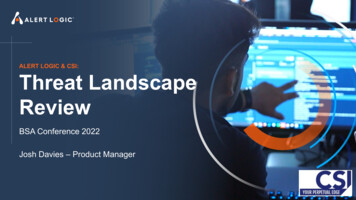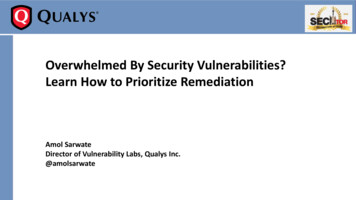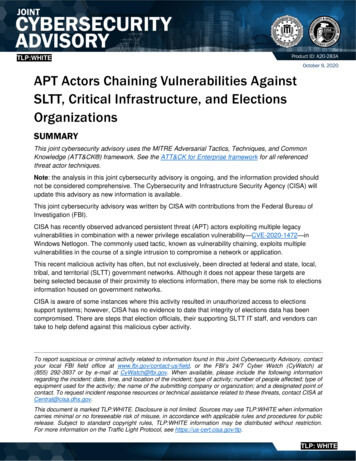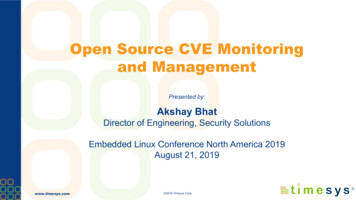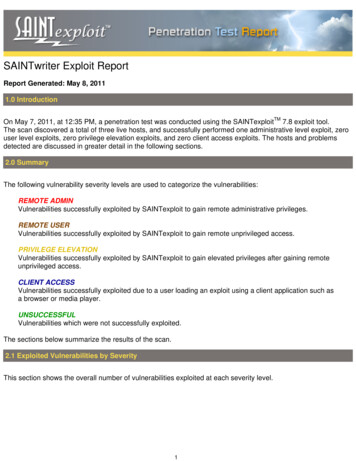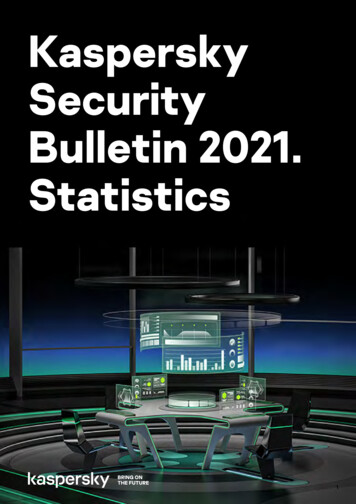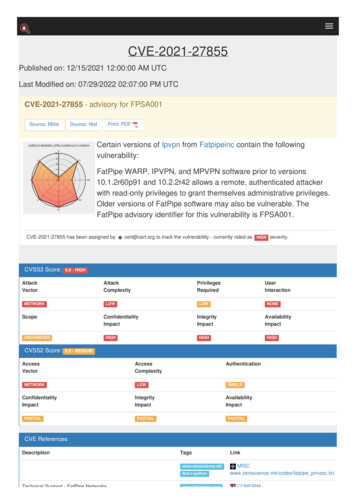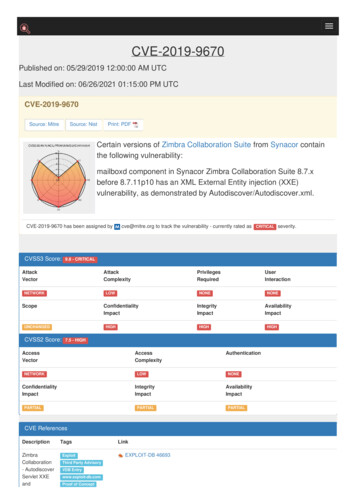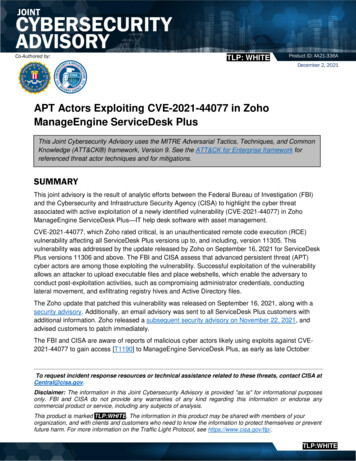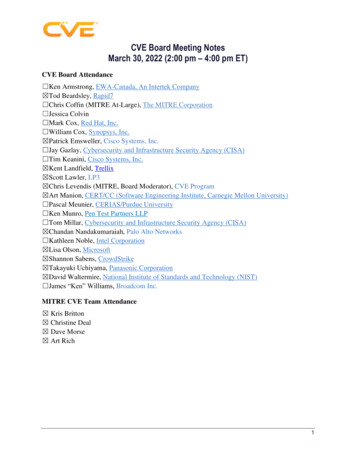
Transcription
CVE Board Meeting NotesMarch 30, 2022 (2:00 pm – 4:00 pm ET)CVE Board Attendance Ken Armstrong, EWA-Canada, An Intertek Company Tod Beardsley, Rapid7 Chris Coffin (MITRE At-Large), The MITRE Corporation Jessica Colvin Mark Cox, Red Hat, Inc. William Cox, Synopsys, Inc. Patrick Emsweller, Cisco Systems, Inc. Jay Gazlay, Cybersecurity and Infrastructure Security Agency (CISA) Tim Keanini, Cisco Systems, Inc. Kent Landfield, Trellix Scott Lawler, LP3 Chris Levendis (MITRE, Board Moderator), CVE Program Art Manion, CERT/CC (Software Engineering Institute, Carnegie Mellon University) Pascal Meunier, CERIAS/Purdue University Ken Munro, Pen Test Partners LLP Tom Millar, Cybersecurity and Infrastructure Security Agency (CISA) Chandan Nandakumaraiah, Palo Alto Networks Kathleen Noble, Intel Corporation Lisa Olson, Microsoft Shannon Sabens, CrowdStrike Takayuki Uchiyama, Panasonic Corporation David Waltermire, National Institute of Standards and Technology (NIST) James “Ken” Williams, Broadcom Inc.MITRE CVE Team Attendance Kris Britton Christine Deal Dave Morse Art Rich1
Agenda 2:00-2:052:05-3:35 3:35-3:553:55-4:00IntroductionTopicso Working Group Updateso Open DiscussionReview of Action ItemsNext Meetings and Future Agenda TopicsNew Action Items from Today’s MeetingActionItem #New Action ItemResponsiblePartyDuenoneWorking Group Updates Automation Working Group (AWG) (Kris Britton)– CVE Services 2.1 entered community penetration testing on February 25 (ZDI,RedHat, Rapid7, Secretariat provided findings)– There are 45 findings with various levels of difficulty to correct. 23 of the findingsrequire fixing prior to the 2.1 release.– Two-week sprints are planned to fix the problems. Sprint 1 is underway andscheduled to complete April 1– A schedule update is in-progress to reflect the impact of the sprints on the releasedate. Summit rescheduling cannot happen without more clarity about when Services2.1 will be operational.– AWG is also working on documentation needed to operate and maintain Services 2.1.– ADP requirements are on the “back burner” for a while due to other priorities. Quality Working Group (QWG) (Dave Waltermire)– The group has received feedback on the JSON 5 record format, and they are workingon adjustments/tweaks to the format.– They are also working with Joe Whitmore and the development team on contentconversion from JSON 4 to 5. QWG is reviewing converted records and providingfeedback.– Dave and Chandan are planning to step down as co-chairs when a suitablereplacement can be identified. Their shifting priorities are making it difficult to keepup with QWG administration (e.g., meeting logistics, notes and distribution, handlingGitHub issues, and documentation development). An estimate of time commitment is4 hours/week.Strategic Planning Working Group (SPWG) (Kent Landfield)2
– Kent mentioned he needs a co-chair; Chris Levendis volunteered help out as needed,at least in the near-term.– CVE Services 2.1 delays are causing a delay to the ADP pilots.– The CVE Working Group Operations Handbook is out for final review, awaitingfeedback.– For disputed tagging, more clarity is needed about how to use it. Kent and DaveWaltermire to get together to discuss.– The question was asked if it would be helpful for all WG chairs to attend the SPWGmeeting. The answer was yes, it would be fine if you have the bandwidth, but bringyour priorities. Chairs can also be invited on an as-needed basis for a particular topic. Outreach and Communications Working Group (OCWG) (Shannon Sabens)– Shannon mentioned she needs a co-chair. A current working group member has beenapproached with the offer, but no decision has been made yet.– There is an interest in better communications and outreach with Researchers. Apodcast focused on Researchers is in-progress, with an estimated mid-April targetdate. Shannon and Bob Roberge are working on message content. A key idea is to getaway from a CNA focus, and instead focus on Researchers and how theycommunicate and relate to a CNA partner. This may evolve into a series of podcasts.– The CNA Newsletter went out March 28. CNA Coordination Working Group (CNACWG) (Tod Beardsley)– The CNACWG meetings no longer include a European time zone occurrence, due tolack of interest. European members are fine with the US time zone occurrence.– The group is working on an idea to create a voluntary CNA mentoring program. Thiswould augment on-boarding orientation sessions and could help bring new CNAs upto speed faster.– A related idea is to send out a periodic survey (e.g., quarterly) to ask new CNAs (3-6months into the program) what they liked about on-boarding and what would havebeen nice to know.– The mentoring program would follow a big brother/big sister model where anexperienced CNA pairs up with a new CNA to help the new CNA understand, forexample, such activities as ID assignment and CVE Record publishing/submission.This is not intended to be a heavy time commitment – maybe 4 hours per month. Itcould also be an opportunity to encourage new CNAs to be active in the programworking groups. An understanding of which CNAs have completed their registrationand are in the pipeline would be helpful to target who needs mentoring. It willprobably take at least two more CNACWG meeting cycles to get a proposal ready forSecretariat involvement/review. Transition Working Group (TWG) (Lisa Olson)– Lisa brought up the idea of having a face-to-face meeting with the TWG members (allthe working group chairs) to discuss the “next big things coming up.” Other Board3
members could attend at their option. A one hour per week meeting is not enoughtime to address all the important things going on right now. Travel was mentioned asa concern, so maybe a 3-hour conference call would be better. This will be discussedfurther at the TWG meeting tomorrow.– It was suggested to reframe the Summit as a workshop to get familiar with the newCVE services. Should include demos, hands-on exercises, etc.Open Discussion Possible New Researcher Working Group– As a follow-on to the OCWG update, Chris Levendis reminded everyone that the ideaof a new researcher working group is still under consideration, and a proposal isbeing worked on for Board review.– The idea is to provide a forum (not just social media) where Researchers and theprogram can collaborate, share concerns, ask questions, etc.– There was some discussion about whether to call it a working group or somethingelse that has a more project-oriented connotation (e.g., advisory committee, specialinterest group, etc.). Council of Roots Meeting Highlights (held March 30, at 8:00 a.m. EDT)– Timeframe for CVE Record Submission The CVE Record Submission timeline target is 5 business days. The topic waswhether that should be changed.Feedback from the meeting indicated that Roots are familiar with the 5%Reserved but Public (RBP) threshold but are not aware of the 5-day bestpractice to submit a CVE Record. CNA on-boarding needs modification tobetter explain this.There was no objection to changing the 5-day submission from a best practiceto a rule (include in the updated CNA Rules document, currently in review).The consensus was to leave the duration at 5 days, and after RSUS has beenoperational for a while, reevaluate.Board comments: 5 days seems a bit long. Automation will help when operational, in terms of speeding up therecord publishing process. With automation, 24 hours should be the goal. Board is okay keeping at 5 days until automation is in place for awhile.– Reserved but Public (RBP) CVE IDs The RBP threshold is 5%, and the topic was whether that should be changed.Refers to a CVE ID that’s been released to the public, for example in aproduct advisory, but is not yet available on the publicly facing CVE List.4
This creates confusion in the user community and results in the programhaving to field a lot of questions. Once the 5% threshold is met, a CNA cannot request any more CVE IDs untilthey work down their current IDs, or they can request a one-for-one swap. After enhanced automation is operational for a while, the program canevaluate whether an adjustment to the 5% threshold is needed. Automation isexpected to make RBPs less of a problem. When CNAs request large blocks of CVE IDs, the program tells them we’retransitioning away from that approach, and they can come back for more IDsover time, as needed. Roots agreed the program should keep the threshold at 5% for now, and thenreevaluate after automation has been in place for a period of time.– Meeting Format Roots liked the meeting agenda format, which was more focused on specifictopics, and less focused on open discussion.Suggested Topics for Future Council of Roots Meetings?– The Board suggested that after SPWG puts together a general framework or modelfor dispute tagging, it can be handed off to the Roots so they can provide input onhow best to operationalize it.Review of Open Action Items NoneNext CVE Board Meetings Wednesday, April 13, 2022, 9:00am – 11:00am (ET)Wednesday, April 27, 2022, 2:00pm – 4:00pm (ET)Wednesday, May 11, 2022, 9:00am – 11:00am (ET)Wednesday, May 25, 2022, 2:00pm – 4:00pm (ET)Wednesday, June 8, 2022, 9:00am – 11:00am (ET)Discussion Topics for Future Meetings CVE Services updates, as neededCVE Program website transition progress, as neededCouncil of Roots meeting highlightsResearcher Working Group proposal for Board reviewVision Paper and Annual ReportCVE Board RecordingsThe CVE Board meeting recording archives are in transition to a new platform. When the newplatform is ready, recordings will be available to CVE Board Members. Until then, to obtain arecording of a CVE Board Meeting, please reach out to the CVE Program Secretariat (cve-progsecretariat@mitre.org).5
The CVE Record Submission timeline target is 5 business days. The topic was whether that should be changed. Feedback from the meeting indicated that Roots are familiar with the 5% Reserved but Public (RBP) threshold but are not aware of the 5-day best practice to submit a CVE Record. CNA on-boarding needs modification to better explain this.
